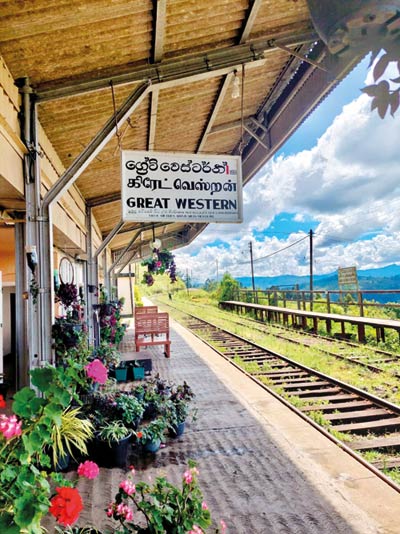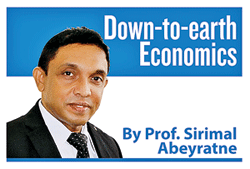At the Great Western…
View(s):
The Great Western railway station.
Midway through a four-day conference in Kandy, we took a field trip to Talawakelle—a welcome shift from theory to terrain. The conference focused on Payments for Ecosystem Services (PES), a concept I introduced in this column a few weeks ago.
PES is a market-based approach to financing environmental conservation. It encourages the protection and sustainable use of ecosystems—such as forests, wetlands, watersheds, coastal zones, mangroves, and coral reefs—by recognising the value of the natural services they provide.
In theory, PES works like this: those who benefit from ecosystem services (the buyers) compensate those who help maintain and enhance these ecosystems (the suppliers). It’s a win-win model that aligns ecological stewardship with financial incentives.
Inactive markets
However, the market for the exchange of ecosystem services is naturally inactive – why?
First, ecosystem services—like clean air, fresh water, and biodiversity—are public goods. One person’s use doesn’t diminish another’s, and without clear property rights, there’s no natural pricing mechanism to incentivise transactions.
Second, there’s a deep information gap. Many landowners and communities don’t realise they’re stewards of valuable ecosystem services. Meanwhile, potential buyers often lack data on where these services originate and what they’re worth.
Third, externalities abound. Ecosystem benefits spill over to non-payers, creating a free-rider problem. Without coordination, stakeholders may wait for others to invest—resulting in under-provision or degradation.
Finally, transaction costs are high. Identifying service sources, valuing them, matching buyers and sellers, and ensuring delivery all require technical expertise, institutional support, and legal frameworks.
A century-old railway
We entered the Great Western Tea Estate of the Hayleys Plantations and began our ascent through the lush plantation, with the majestic Great Western mountain range rising above us; behind us, sweeping views of tea plantations and distant misty hill tops, including Adam’s Peak.
Silver streams shimmered down the slopes in the morning sun—our main focus for the field visit. Their glinting descent through the landscape was a striking reminder of the ecosystem services we had come to explore.
Crossing the Great Western railway line, we stepped into history. The track, unchanged for over a century, still bore the hallmarks of its British colonial origins. Original wooden trestles supported the elevated railway track, with occasional concrete patches replacing decayed logs. Much of the crushed stone once used for drainage and stability had vanished, leaving the track weathered and worn.
A tourist-packed express train—some passengers clinging to open doors—rattled through the station. The old, pivoted signal arm with its colored lenses, still guided its passage. As tradition holds, the station master exchanged the tablet with the driver of the running train, clearing the way ahead.
Trespassers on railway
While walking and snapping a few photos, my eye caught a partly broken off, cast iron notice board by the tracks. It bore a trilingual warning: “Trespassers on the railway will be prosecuted.” Yet in all my years, I have never heard of anyone being prosecuted for walking along the tracks.
In reality, railway reservations on either side have long been encroached—used not just by pedestrians, but also for housing and commercial structures.
The British once enforced strict laws to instill discipline in colonial Sri Lanka. But after independence, many of those regulations were dismissed with irony, and eventually abandoned. What remains is a relic of intent, now weathered by time and neglect.
Dilapidated state of affairs
My reflections on the neglected railway and discarded colonial-era regulations weren’t without purpose. They set the stage for a deeper conversation: It is in this challenging backdrop that Sri Lanka may have to introduce innovative finance solutions to protect our ecosystem services.
 As discussed in earlier columns, Sri Lanka’s geography makes ecosystem management critical. With a fragile hill country at its heart and a coastal belt all around, the island is highly vulnerable to climate change, biodiversity loss, and pollution—threats that directly impact the survival and wellbeing of its people.
As discussed in earlier columns, Sri Lanka’s geography makes ecosystem management critical. With a fragile hill country at its heart and a coastal belt all around, the island is highly vulnerable to climate change, biodiversity loss, and pollution—threats that directly impact the survival and wellbeing of its people.
Our field visit ended at a 200-acre stretch of land within the tea estate, nestled between the Great Western mountain range and the railway line. Streams from the mountains flow through this land, feeding canals that serve Talawakelle and nearby areas, eventually joining the country’s vast network of rivers flowing to the sea.
Remarkably, the estate’s management has chosen not to cultivate tea or use agrochemicals here. Instead, they have preserved the land for biodiversity conservation. As a result, the water streams flowing through remains clean and uncontaminated—a living example of ecosystem stewardship.
Should we pay?
This 200-acre stretch of land within the Great Western Tea Estate plays a vital role in sustaining downstream water flows. Its beneficiaries include village communities, schools, hospitals, Talawakelle households and businesses reliant on piped water, and small-scale hydropower plants. All depend on a steady supply of clean, uncontaminated water throughout the year.
Yet, preserving this land comes at a cost. The estate has foregone tea cultivation and agrochemical use—an opportunity cost borne by its management. Shouldn’t those who benefit from this ecosystem service contribute to its upkeep?
From another angle, there’s nothing stopping the company from converting the land back to tea cultivation. Doing so would yield private returns—but at the expense of water quality for all downstream users.
This is a textbook case for a PES scheme. The beneficiaries of clean water are the buyers; the Tea Estate, which safeguards its source, is the seller. Through a negotiated payment, both parties engage in a market-like exchange—aligning private incentives with public good.
Complications
The site at Great Western is merely a surface-level symptom. Sri Lanka’s central highlands—rich in mountains, tea estates, and native vegetation—are the lifeblood of the nation’s hydrology, feeding hundreds of rivers. The government agencies too hold unutilised or underutilised lands which bear detrimental effects on biodiversity and ecosystem services.
To protect these ecosystem services, we need more than good intentions. Identifying service sources, valuing them, setting benchmarks, and tracking improvements all demand technical expertise. Equally important is building the legal framework and intermediary institutions to enable a functioning market for ecosystem service exchange.
Another challenge lies in land ownership. Tea estates are government-owned and leased to plantation companies for a limited period. What incentive do these companies have to invest in long-term ecosystem stewardship, when their leases may soon expire? Without clear, long-term policy direction, expecting sustainable practices from plantation managers is unrealistic.
The complications pose challenges, but not make the PES impossible to implement, as many countries have been developing such schemes to manage their biodiversity and ecosystem services. Below is the case of Kumamoto Prefecture in Japan where PES was initiated some 20 years ago for ground water recharge through agricultural land use.
PES from Japan
Kumamoto depends heavily on groundwater for drinking, farming, and industrial use. To keep this supply stable, water must remain underground throughout the year. However, rapid urbanisation, declining rice cultivation, and rising industrial demand have led to groundwater depletion.
One major industrial user is Sony Semiconductor Kyushu Corporation, a key subsidiary of the Sony Group, employing thousands of workers. Semiconductor production requires large volumes of ultra-pure water, making a steady groundwater supply essential for uninterrupted operations.
To address this, the company launched an innovative PES scheme. It pays local farmers to keep their paddy fields flooded between crop cycles. This practice allows water to slowly seep into underground aquifers, helping to recharge the groundwater supply.
The Kumamoto PES model brought together multiple stakeholders—semiconductor firms, environmental NGOs, agricultural cooperatives, land improvement districts, and the Kumamoto City government. Today, it stands as a global example of how ecosystem services can be protected through smart collaboration and financial incentives.
Concluding remarks
The hill country of Sri Lanka—home to vital watersheds, tea plantations, and biodiverse forest reserves—is not just a scenic landscape; it is the beating heart of the nation’s water security-related ecosystem services.
The decision by the Great Western Tea Estate management to preserve a 200-acre stretch for biodiversity conservation—foregoing agrochemical use and tea cultivation—demonstrates the kind of stewardship that PES can reward. Downstream beneficiaries, from households and hospitals to hydropower plants, rely on this clean water supply.
Yet, without financial recognition of the estate’s opportunity cost, such conservation efforts remain vulnerable. Implementing PES in the hill country is not only important—it is feasible as demonstrated by the many case studies around the world, including the Kumamoto model in Japan.
(The writer is Emeritus Professor at the University of Colombo and Executive Director of the Centre for Poverty Analysis (CEPA) and can be reached at sirimal@econ.cmb.ac.lk and follow on Twitter @SirimalAshoka).
Hitad.lk has you covered with quality used or brand new cars for sale that are budget friendly yet reliable! Now is the time to sell your old ride for something more attractive to today's modern automotive market demands. Browse through our selection of affordable options now on Hitad.lk before deciding on what will work best for you!


